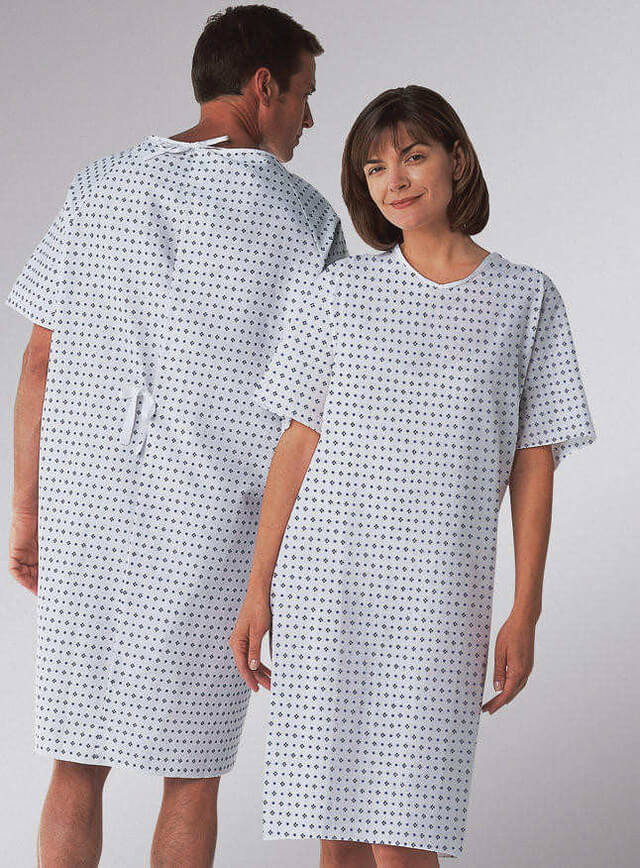What are the Different Types of Hospital Gowns?
Hospital gowns are an important part of patient care, as they offer comfort, access for medical examinations, and modesty. Direct Textile Store offers a variety of bulk patient gowns and in this blog we will discuss the designs and materials of patient gowns and how important they are for ensuring patients' well-being and comfort.
Why Do Hospital Gowns Open in the Back?
Hospital gowns open in the back for several important reasons:
1. Examination Access: Patient Gowns are designed to provide medical professionals with easy access to the patient's body for examinations, treatments, and procedures. The open-back design allows healthcare providers to assess and treat various parts of the patient's body quickly and efficiently.
2. Hygiene and Infection Control: Patient gowns minimize the risk of contamination. The open-back design reduces the chance of contact between the patient's clothing and any potentially contaminated surfaces, helping to maintain a sterile environment in medical settings.
3. Modesty: While Patient gowns may feel revealing to patients, they are intentionally designed to protect their modesty. The front of the gown typically overlaps to maintain coverage when the patient is sitting or standing, ensuring that their front remains adequately covered.
4. Ease of Dressing: Patient gowns are easy to put on, even for patients with limited mobility. The open-back design simplifies the process of dressing and undressing, which can be challenging for patients in medical situations.
What are the most popular types of hospital gowns?
Patient gowns are an important part in healthcare settings, providing patients with comfort, modesty, and accessibility during medical procedures and hospital stays. While traditional gowns have been a mainstay in healthcare facilities for decades, there has been a growing demand for alternatives that offer improved functionality, patient satisfaction, and infection control. Let's explore some of the most popular types of gowns and their unique features:
1. Traditional Hospital Gowns: Traditional patient gowns have been a staple in healthcare settings for generations. These gowns typically feature an open-back design with ties or snaps at the shoulders and waist, allowing for easy access to the patient's body for medical examinations and procedures. While they provide ample coverage and accessibility, traditional gowns are often criticized for their lack of comfort, modesty, and dignity. Patients may feel exposed and vulnerable wearing these gowns, leading to dissatisfaction with their hospital experience.
2. Front-Opening Gowns: Front-opening gowns are a popular alternative to traditional gowns, offering improved accessibility and patient comfort. Unlike traditional gowns, front-opening gowns feature a wrap-around design with openings at the front, secured with snaps or hook-and-loop fasteners. This design allows patients to easily put on and take off the gown without assistance, enhancing their sense of independence and dignity. Front-opening gowns also provide healthcare providers with easy access to the patient's body for medical examinations and procedures, making them a practical choice in hospital settings.
3. Patient Gowns with Adaptive Features: Patient gowns with adaptive features are designed to meet the specific needs of patients with mobility limitations, disabilities, or medical conditions. These gowns may feature additional closures, adjustable straps, or side openings to accommodate medical devices, IV lines, or catheters. Adaptive patient gowns prioritize patient comfort and dignity while ensuring that medical care can be delivered safely and effectively. By addressing the unique challenges faced by patients with special needs, adaptive patient gowns contribute to a more inclusive and patient-centered healthcare environment.
4. Disposable Patient Gowns: Disposable patient gowns are a hygienic and convenient option for hospitals and healthcare facilities. Made from lightweight, non-woven materials, disposable gowns are designed for single-use and can be easily discarded after each patient encounter, reducing the risk of cross-contamination and healthcare-associated infections. Disposable gowns are available in a variety of styles, including traditional open-back gowns and front-opening gowns, providing healthcare providers with flexibility in their choice of protective attire.
5. Reusable Patient Gowns: Reusable patient gowns offer a sustainable alternative to disposable gowns, reducing waste and environmental impact in healthcare settings. These gowns are typically made from durable, machine-washable fabrics such as cotton or polyester blends, ensuring long-lasting performance and comfort for patients. Reusable patient gowns may feature adjustable closures, reinforced seams, and antimicrobial properties to enhance durability and infection control. While reusable gowns require laundering between uses, they offer cost savings and environmental benefits over time.
6. Pediatric Patient Gowns: Pediatric patient gowns are specially designed for children and infants receiving medical care in hospitals and clinics. These gowns feature child-friendly designs, colorful patterns, and playful prints to help alleviate anxiety and promote a positive healthcare experience for young patients. Pediatric patient gowns may also include adaptive features such as adjustable closures and soft, breathable fabrics to ensure comfort and mobility for children of all ages. By catering to the unique needs of pediatric patients, these gowns contribute to a child-friendly and supportive healthcare environment.
How to Tie a Hospital Gown?
Tying a hospital gown correctly is essential for ensuring proper coverage and modesty. Here's a basic guide on how to tie a hospital gown:
1. Step into the Gown: Begin by stepping into the hospital gown and ensuring that the opening is at the back.
2. Secure the Neck Ties: Locate the neck ties, which are typically positioned on the shoulders. Tie them securely to ensure that the gown stays in place and covers the front adequately.
3. Fasten the Waist Ties: Hospital gowns usually have waist ties or closures. Cross the ties behind your back and bring them to the front. Tie the waist ties securely to maintain coverage.
4. Adjust as Needed: After tying the neck and waist ties, adjust the gown to ensure that it fits comfortably and provides sufficient coverage at the front.
Remember that gowns are designed for convenience and easy access, so tying them securely is essential to maintain modesty during medical procedures.
What Are Hospital Gowns Made Of?
Hospital gowns are typically made of lightweight and breathable materials that prioritize patient comfort. Common materials used for hospital gowns include:
1. Cotton: Cotton hospital gowns are soft, comfortable, and breathable. They are suitable for various medical procedures and help patients stay cool.
2. Polyester-Cotton Blends: These blends offer the benefits of both polyester (durability and wrinkle resistance) and cotton (comfort and breathability). They are commonly used in hospital gown manufacturing.
3. Disposable Materials: Some hospital gowns are made of disposable materials, such as non-woven fabrics. These gowns are designed for single-use and help maintain infection control.
4. Flame-Resistant Materials: In specific medical settings, flame-resistant hospital gowns made of specialized materials are used to ensure patient safety.
For a reliable source to purchase hospital gowns made from high-quality materials, here at Direct Textile Store (directtextilestore.com) we offer a wide selection of hospital gowns suitable for various medical and healthcare needs. Our gowns prioritize patient comfort and are designed to meet the requirements of medical professionals.
Direct Textile Store offers a variety of hospital gowns that are designed to open in the back for medical access while maintaining patient modesty. Understanding the different types of gowns and how to tie a hospital gown correctly is important for patient comfort and coverage. Hospital gowns are typically made from lightweight and breathable materials like cotton and polyester-cotton blends, prioritizing patient comfort during medical procedures. When looking for high-quality hospital gowns, Direct Textile Store is a reliable source offering a range of options designed for patient well-being and medical professionalism.
About the Author
Haley Bridges, Marketing Assistant at Direct Textile Store
Haley Bridges has served as Marketing Assistant at Direct Textile Store, where she specializes in hospitality linens, uniforms, and bulk textile solutions. She works closely with hotels, restaurants, and healthcare facilities to match them with durable, high-quality products that balance both performance and value. Haley's expertise in textile sourcing and merchandising strategy helps businesses make confident purchasing decisions while staying ahead of industry trends.
If you need assistance, contact Direct Textile Store Customer Service at 800-615-5822






